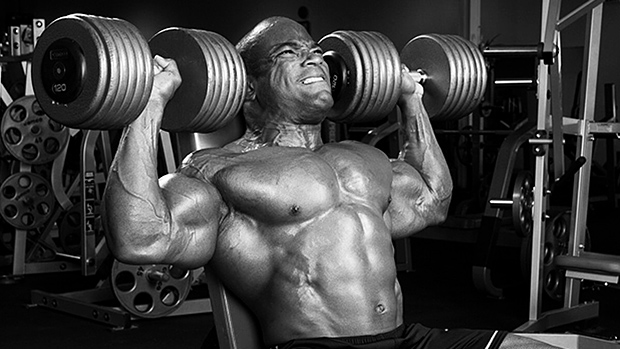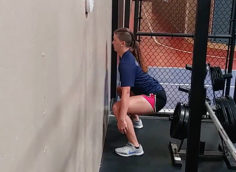Here's what you need to know...
- In order to maximize the size of your biceps peak and arm circumference, you can't overlook the brachialis.
- The brachialis literally pushes the biceps up as it gets bigger, making the biceps appear taller.
- The key to maximizing recruitment of the brachialis is to do elbow flexion with a neutral or hammer grip.
- Err toward the slower side of rep speed vs. a quicker tempo in order to maximize the stress placed on the brachialis.
- The biceps has two distinct heads and it's possible to emphasize one head or the other. Doing barbell curls with a narrower grip will emphasize the long head; wider-grip curls emphasize the short, inner head.
- Curling the bar to the nose will force the long head of the biceps to contract across both ends, providing a peak contraction.
- To jumpstart biceps growth, hit them hard on three nonconsecutive days per week for six weeks.
Don't Forget the Brachialis!
You can't begin to maximize the size of your biceps peak and arm circumference without also addressing the underlying and often-overlooked brachialis.
Like the biceps, the brachialis is an elbow flexor. Due to its position under the biceps, it literally pushes the biceps up as it gets bigger, making the biceps appear taller. Likewise, a well-developed brachialis increases the overall circumference of the upper arm.
If that's not enough, the brachialis is also visible on the side (lateral aspect) of the arm, as when doing a rear double biceps pose. You've gotta be pretty lean to be able to see the brachialis, but even if you've got some chub over it, your arm will still look thicker if your brachialis is properly developed.
In short, you really need to have a thick brachialis if you want bodybuilder-looking guns. But how do you go about accomplishing that?
Hammer It
The key to maximizing recruitment of the brachialis is to do elbow flexion with a neutral grip, often called a hammer grip in bodybuilding circles. This shifts the stress away from the biceps brachii and onto the brachialis.
For the record, this will also hit the brachioradialis quite well. Although it's visually more of a forearm muscle, it's also an elbow flexor and you of course want it to be developed, too.
If there's one exercise for the brachialis that's like squats are for quad development, it's the dumbbell hammer curl. To execute it, simply curl the dumbbell up while keeping the grip portion of the dumbbell in alignment with your humerus.
This puts your wrist in that neutral position, which is simply half way between supination (palm up) and pronation (palm down). If you get confused, just think about the wrist position you'd use to grab a hammer.
In addition to the dumbbell hammer curl, you could also do neutral-grip barbell curls if you're lucky enough to have access to one of those old school bars with the vertical handles.
Likewise, the rope hammer curl is a great option. Simply attach a rope – like you'd typically use for rope pushdowns – on a low pulley and off you go. Reverse curls are also a valid option, even though they target the brachioradialis a bit more.
To synopsize, the following movements target the brachialis:
- Dumbbell Hammer Curl
- Neutral-Grip Barbell Curl (using "French curl" bar)
- Rope Hammer Curl
- Reverse Curl
Don't worry about having to use a variety of hand positions and/or arm angles to stimulate it, though, because the brachialis only has one head and doesn't cross the shoulder joint. But, as with any muscle, you should use a variety of rep ranges to maximize hypertrophy.
Brachialis Rep Speed – Slower is Better
Another thing to keep in mind when you want to maximize recruitment of the brachialis is repetition speed, specifically the eccentric (aka negative) portion of the repetition.
One study found that doing the eccentric component more slowly increased activity of the brachialis, while decreasing activity of the biceps brachii.
This is thought to be because the brachialis tends to have more slow-twitch fibers than the biceps. Likewise, the brachialis plays a bit more of a stabilizing role and the biceps are more for faster, explosive movements.
Although the aforementioned study isn't perfectly applicable (they were doing supinated elbow flexion and comparing a 10-second vs. 2-second negative), it's still a good idea to err toward the slower side of rep speed vs. a quicker tempo in order to maximize the stress placed on the brachialis.
As for number of exercises, doing one brachialis-targeting exercise as part of your biceps routine is sufficient. However, if you're like many people who have an underdeveloped brachialis, then consider doing at least two neutral-grip elbow flexion exercises every other biceps workout.
On to the Biceps!
The biceps brachii has two separate heads, the long head and the short head. The long head is situated on the lateral aspect while the short head is on the medial aspect.
You can think of the long head as the "outer" bicep, which would be seen when doing a rear double biceps pose, and the short head as the "inner" bicep, visualized when hitting a front double bi.
Because the muscle has two distinct heads, it's possible to emphasize one head or the other during curls. For example, doing barbell curls with a narrower grip will emphasize the long head more, while wider-grip curls emphasize the short, inner head more.
The long head of the biceps crosses the shoulder joint so there are a couple other techniques you can use that will arguably hit it a bit harder, one of which is to pre-stretch the long head, as with incline dumbbell curls.
Much like overhead triceps extensions emphasize the long head of the triceps, starting the dumbbell curl with your humerus hyper-extended (as it is in the starting position of an incline curl) will pre-stretch the long head and force it to work a bit harder.
Although the effect isn't quite as significant as it is with overhead triceps extensions, it's still worth doing, even if for no reason other than providing another type of stimuli.
You can also make the long head contract more. Since the long head crosses the shoulder joint, it plays a role in shoulder flexion. So instead of keeping your humerus along your side during the entire curl, bring your elbows forward a bit as you approach the top, fully-contracted portion of the curl.
Take the barbell curl, for example. Curl the bar to your nose. That will force the long head of the biceps to contract across both ends, thus providing a really nice peak contraction.
Maximizing Your Peak
Without a doubt, the overall shape of your biceps is largely determined by genetics, so thank or blame your parents accordingly.
However, the long head does have more of a propensity toward being more highly peaked than the short head. Therefore, if you want to maximize the peak of your biceps, it's worth doing an exercise or two that emphasizes the long head.
You can target the long head via:
- Narrow-Grip Curl, best done on a cambered/EZ bar
- Incline Dumbbell Curl, and/or Barbell Curl to nose
Speed, Sets, & Frequency
Remember, slower curls emphasize the brachialis and faster curls hit the biceps a bit more. With that in mind, it makes sense to do some of your curls with a quicker tempo.
We do want to keep your biceps attached to their tendon and that tendon attached to your radius, so don't get all crazy here! Still, keeping the eccentric portion of the curl between one and two seconds (versus longer) is a good idea to maximize biceps recruitment.
As for the number of sets you should do for biceps, it depends largely on how intense the sets are and how often you're going to train biceps.
Take most non warm-up sets to, or very near, concentric failure, hitting biceps about every 5-7 days. Given those parameters, doing about 9-12 sets (not counting light warm-up sets) in a biceps and brachialis workout is about right if you really want to maximize growth. Divide those sets across 3-4 different exercises to provide a variety of stimuli to the elbow flexors.
If you're going to implement intensity-boosting techniques like forced-reps and/or negatives, you should err toward fewer sets so you can still recover optimally. Generally, save these techniques for special occasions to avoid overtraining.
The Rapid Growth Plan
Even though a general recommendation is to work biceps every 5-7 days, one of the best ways to jumpstart biceps growth is to train them more often for brief periods of time. Hitting bi's on three nonconsecutive days per week (i.e., Mon, Wed, Fri) for about six weeks tends to work really well.
Although I'd encourage you to try high-frequency biceps training, you need to make a couple of modifications for it to work. For starters, only do two exercises (typically three sets each), during each of these thrice-weekly workouts. Next, stop a rep or two short of failure.
Reps
In bodybuilding, regardless of the body part, it's pretty much always advisable to hit a variety of rep ranges and even rest periods.
Keeping in mind that your number of reps and amount of rest between sets should be inversely proportional, here are a couple of examples of different rep ranges/rest periods:
- 5 x 5 with 120 seconds rest
- 3 x 8-12 with 75 seconds rest
- 4 x 12-15 with 30 seconds rest
The first scenario maximizes the mechanical tension placed on the biceps, which does a great job causing protein synthesis and neuromuscular improvements.
The last maximizes metabolic fatigue and the blood volumization response, leading to hypertrophy of "stuff" other than actin and myosin. And the 3 x 8-12 is that sweet spot right in the middle.
Because your goal is size, you want to stress – and induce hypertrophy of – all the various components of the muscle cell. Therefore, variety truly is key here.
Reference
- Kulig, K, et. al. The effects of eccentric velocity on activation of elbow flexors: evaluation by magnetic resonance imaging. Medicine & Science in Sports & Exercise, 2001.









